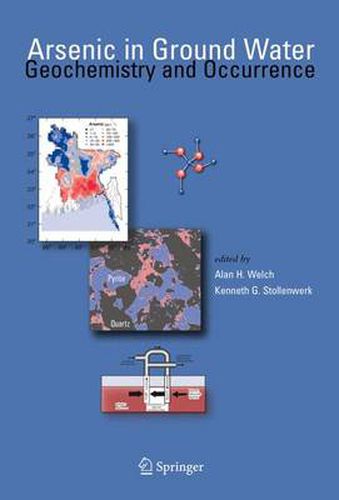Readings Newsletter
Become a Readings Member to make your shopping experience even easier.
Sign in or sign up for free!
You’re not far away from qualifying for FREE standard shipping within Australia
You’ve qualified for FREE standard shipping within Australia
The cart is loading…






This title is printed to order. This book may have been self-published. If so, we cannot guarantee the quality of the content. In the main most books will have gone through the editing process however some may not. We therefore suggest that you be aware of this before ordering this book. If in doubt check either the author or publisher’s details as we are unable to accept any returns unless they are faulty. Please contact us if you have any questions.
Potable water supplies that contain arsenic concentrations high enough to pose a human health hazard are a problem of international proportion. Surface water and ground water are both at risk of arsenic contamination. However, most incidences of high concentrations of arsenic have been reported for ground water, which is the subject of this book. The geochemistry of arsenic in aqueous environments is complex. This book consolidates much of what is known about the geochemistry of arsenic and provides new information on relationships between high concentrations of arsenic in ground water and geochemical environments. The subject matter of this book ranges in scope from molecular-scale geochemical processes that affect the mobility of arsenic in ground water, to aresnic contaminated ground water at the national scale. Chapters were contributed by an international group of research scientists from a broad range of backgrounds. Information includes reviews of existing thermodynamic data for arsenic containing mineral phases and aqueous arsenic species, factors that affect adsorption of arsenic in common ground water environments, and spectroscopic techniques used to determine the chemical reactions controlling arsenic partitioning between solid and liquid phases at particle-water interfaces. A significant portion of this book is devoted to regions where high concentrations of arsenic in ground waters have a natural source. The original source of arsenic can vary; however, arsenic becomes concentrated in the solid and aqueous phases of an aquifer given appropriate geochemical conditions. Often, high arsenic concentrations in the solid phase become mobile if there is a change in ground water chemistry, either natural or anthropogenically induced. Research presented in this book covers several different geologic settings and provides explanations of the geochemical processes that have caused the arsenic concentrations observed in ground water. In situ remediation of arsenic-contaminated ground water can provide a relatively inexpensive alternative to above ground treatment. One chapter of this book discusses natural remediation of an aquifer where naturally occurring arsenic was mobilized by leachate from a landfill. Two chapters discuss results from field experiments designed to alter aquifer geochemistry in order to remove arsenic from ground water prior to withdrawal. This book should be of interest to scientists working in the field of arsenic, health professionals interested in arsenic exposure, and water-resource managers and regulators.
$9.00 standard shipping within Australia
FREE standard shipping within Australia for orders over $100.00
Express & International shipping calculated at checkout
This title is printed to order. This book may have been self-published. If so, we cannot guarantee the quality of the content. In the main most books will have gone through the editing process however some may not. We therefore suggest that you be aware of this before ordering this book. If in doubt check either the author or publisher’s details as we are unable to accept any returns unless they are faulty. Please contact us if you have any questions.
Potable water supplies that contain arsenic concentrations high enough to pose a human health hazard are a problem of international proportion. Surface water and ground water are both at risk of arsenic contamination. However, most incidences of high concentrations of arsenic have been reported for ground water, which is the subject of this book. The geochemistry of arsenic in aqueous environments is complex. This book consolidates much of what is known about the geochemistry of arsenic and provides new information on relationships between high concentrations of arsenic in ground water and geochemical environments. The subject matter of this book ranges in scope from molecular-scale geochemical processes that affect the mobility of arsenic in ground water, to aresnic contaminated ground water at the national scale. Chapters were contributed by an international group of research scientists from a broad range of backgrounds. Information includes reviews of existing thermodynamic data for arsenic containing mineral phases and aqueous arsenic species, factors that affect adsorption of arsenic in common ground water environments, and spectroscopic techniques used to determine the chemical reactions controlling arsenic partitioning between solid and liquid phases at particle-water interfaces. A significant portion of this book is devoted to regions where high concentrations of arsenic in ground waters have a natural source. The original source of arsenic can vary; however, arsenic becomes concentrated in the solid and aqueous phases of an aquifer given appropriate geochemical conditions. Often, high arsenic concentrations in the solid phase become mobile if there is a change in ground water chemistry, either natural or anthropogenically induced. Research presented in this book covers several different geologic settings and provides explanations of the geochemical processes that have caused the arsenic concentrations observed in ground water. In situ remediation of arsenic-contaminated ground water can provide a relatively inexpensive alternative to above ground treatment. One chapter of this book discusses natural remediation of an aquifer where naturally occurring arsenic was mobilized by leachate from a landfill. Two chapters discuss results from field experiments designed to alter aquifer geochemistry in order to remove arsenic from ground water prior to withdrawal. This book should be of interest to scientists working in the field of arsenic, health professionals interested in arsenic exposure, and water-resource managers and regulators.